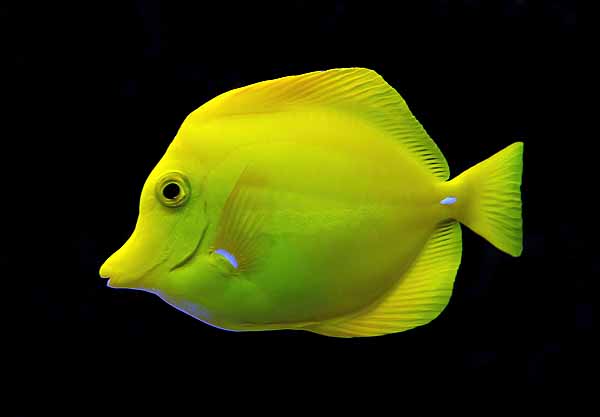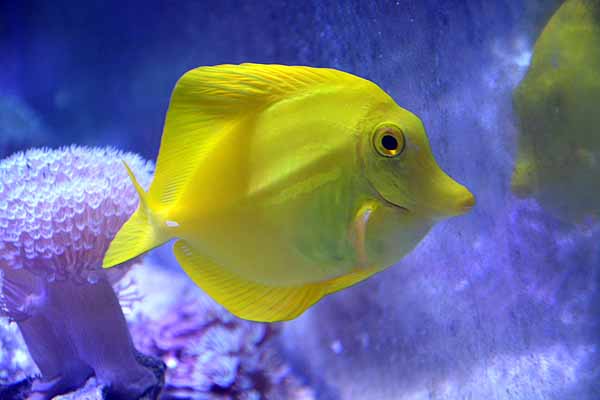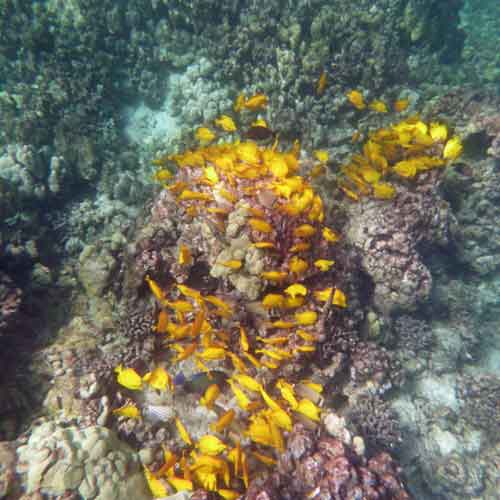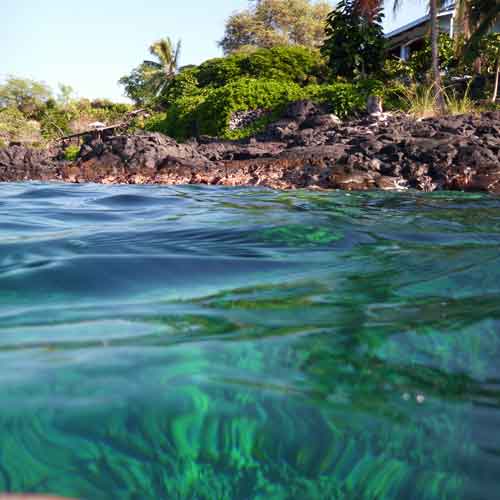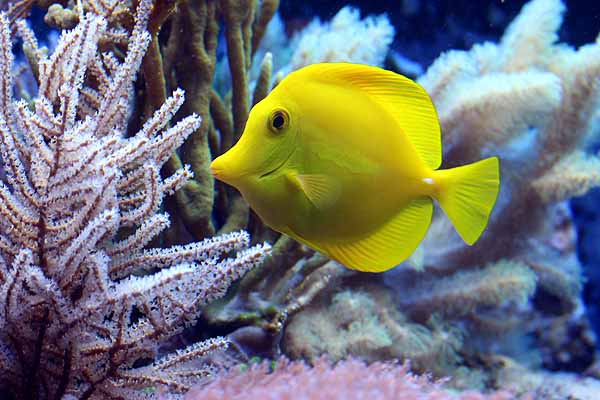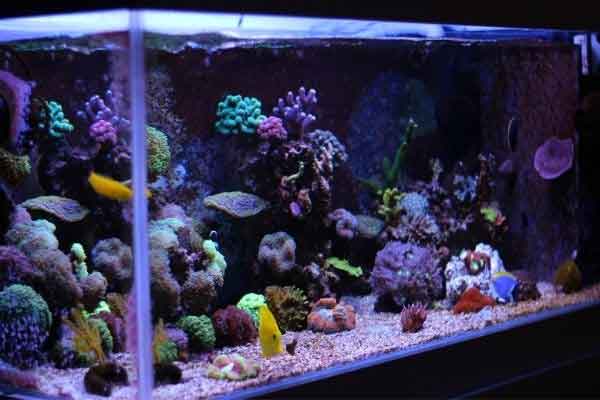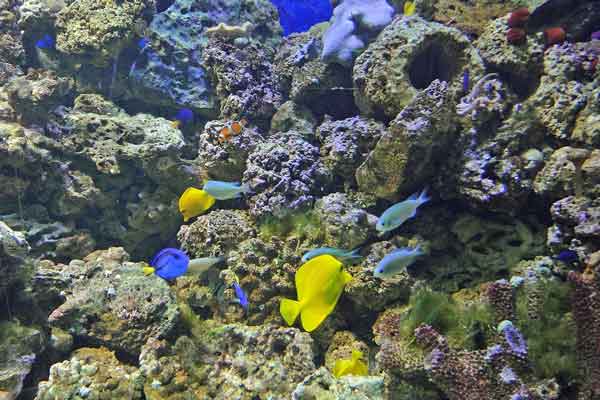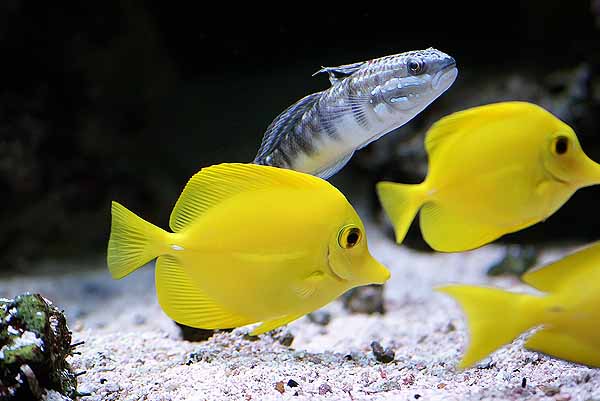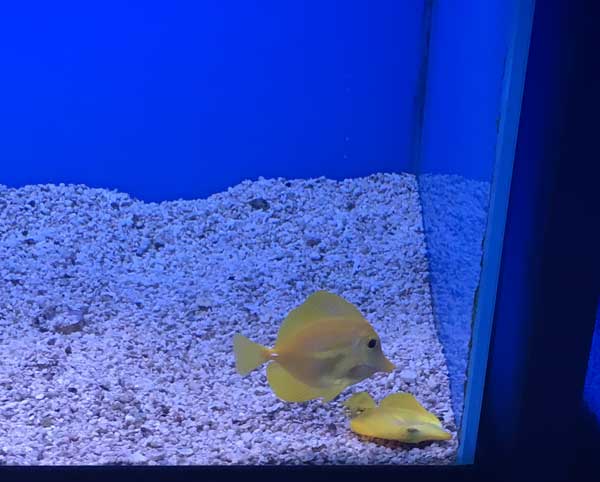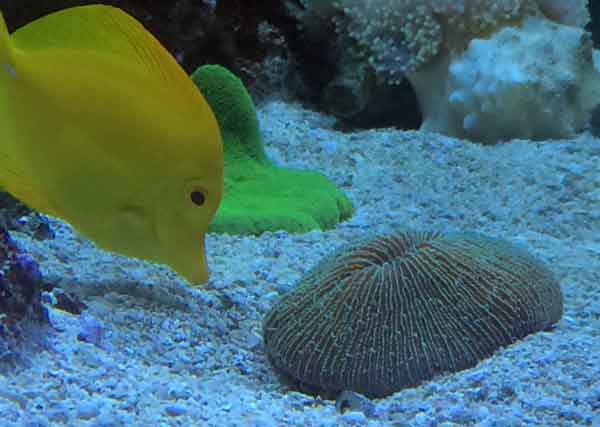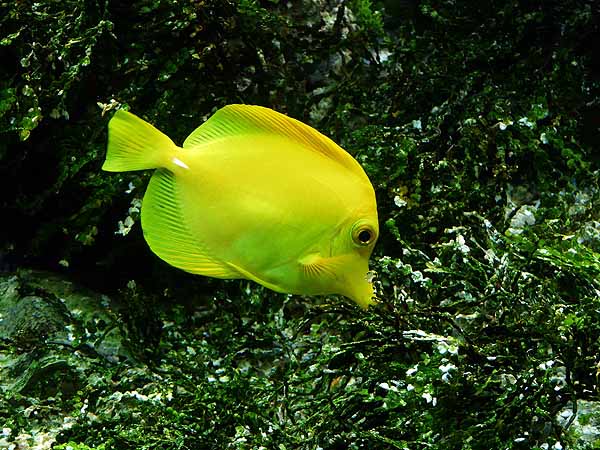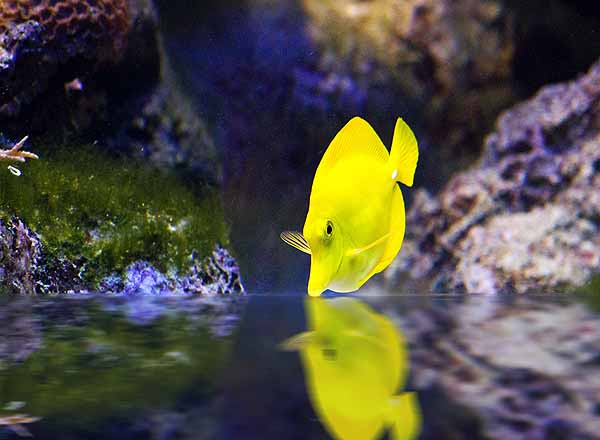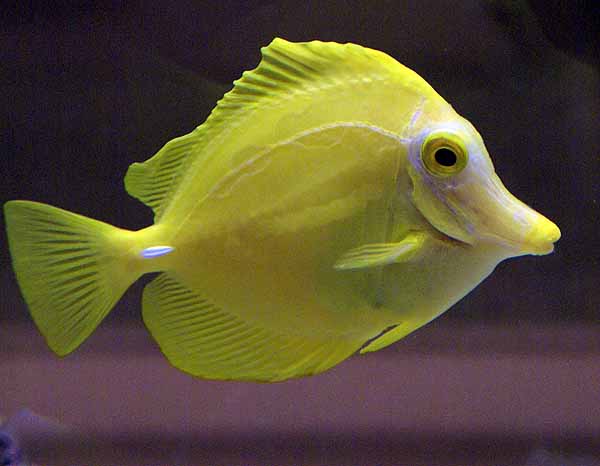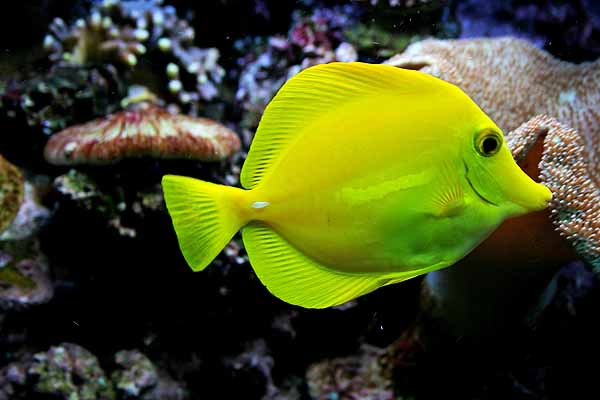[ad_1]
The Yellow Tang is one of the most common saltwater fish, because of its striking color, fantastic shape, bold personality, and relative ease of care. They will add a pop of color and the frenzied reef fish motion we all love to even the brightest reef tank.
Table of contents
Introduction
They are, (not surprisingly), yellow in color (shocking…I know), ranging from a pastel-y buttery color to an almost neon color that changes based on age, season, and time of day. Don’t be alarmed if the fish looks dull at night because these fish become a dull almost grey-ish color at night to aid in camouflage when they bed down.
I know I was freaked out the first few times I saw that.
They are disc-shaped with almost equal height and length when all seven of their fins are fully extended. They have sharp white spines on their tales for self-defense which is the only part of them that is not yellow.
Known for being outgoing, generally friendly fish, yellow tangs need lots of room to swim and a space ready for them to grow into. They are reef compatible herbivores with a seemingly natural curiosity.
Yellow tang fish care facts
- Common names: Yellow tang fish, Lemon surgeonfish, Hawaiian tang
- Scientific name: Zebrasoma flavescens
- Genus: There are 7 other well-known members of this genus
- Size: ~8 inches (20-21 cm), disc-shaped
- Minimum tank size: 90 gallons +
- Reef safe: yes
- Care or experience level: easy, appropriate for all levels of experience
- Preferred diet: Algae eater, will eat meaty foods if offered
- Captive-bred available: Technically, yes, but not the most commonly available
- Original part of the world: Hawaiian reefs and the Pacific Ocean reefs
Yellow tang fish scientific name and common names
The scientific name of the yellow tang is Zebrasoma flavescens.
The natural habitat of the Yellow tang fish
Yellow tangs live in subtropical waters from the Western Coast of Hawaii to the Eastern Coast of Japan. Their main population is found in Hawaii and the majority of all yellow tangs caught come from the Kona Region (The West Coast of the Big Island). They inhabit coral reefs and shallow waters near the continental shelf.
They tend to live lower in the water column where the water is calmer. Juvenile yellow tangs tend to live in deeper waters farther from the reefs with their move into the shallower coral reefs corresponding with them reaching sexual maturity.
I was fortunate to get to see shoals of them off the cost of the Big Island of Hawaii, as shown in the image above.
Yellow tangs have historically been Hawaii’s largest fish export making up 80% of all fish caught for the aquarium trade, off its coasts. In 1990, Fish Replenishment Areas were set up off the Kona Coast which prevents the collection of fish for aquarium sales in 30% of the area.
At this time, the Tang’s population is listed as stable and there is no shortage of specimens in the areas where the collection is allowed. The yellow tang will likely remain one of the most popular saltwater fish, as long as the legislation allows.
The yellow tang does not have any specific water quality needs. As long as you are able to maintain stable levels of the key water parameters and use a high-quality salt, you should be covered.
Learn about the best reef salt mix here.
Yellow tang tank size
Yellow tangs are constant swimmers that graze constantly. It is recommended to keep them in a tank that is at least 90 gallons (340 liters) in size to allow them sufficient room to swim about and graze.
Yellow tangs often arrive at pet stores small (sometimes 2 inches or smaller), but it is important to keep in mind that these tiny little rays of sunshine can grow to be 8-inch fish who are quick swimmers requiring lots of room to move around.
Tangs are bold and active fish that will be very visible in your tank during the day. and sleep at night). They are in need of space to swim freely in the upper portion of the tank during their active periods but need rocks and coral at the bottom of the tank to hide in at night.
Because of their need for room to swim, since they are in constant motion, the best yellow tang tank size is one that is at least 90 gallons in volume, or larger. Determining the minimum appropriate tank size for tangs is one of the larger controversies/debates in the hobby.
Some sources recommend that fully-grown tangs need at least 6 feet of linear open space to swim in. Chat forums for hobbyists seem to have groups of yellow tang vigilantes who have made it their mission to protect tangs from tanks that are too small. To be safe on the forums and avoid getting shamed, don’t keep tangs in tanks under 90 gallons, and make sure they have lots of free space to swim in the open!
Get started with your own tank by learning how to set up a saltwater aquarium.
Compatibility
Yellow tangs are extremely popular community fishes, considered to have a “semi-aggressive” temperament. That means, generally speaking, that they can and will get along with most other community saltwater aquarium fish, although you should expect some squabbling over territories and food.
It also means that any fish added after the yellow tang may be more likely to receive the brunt of their semi-aggression.
Tangs display aggression by flaring their fins and swimming sideways or backward towards the target fish, showing off their size and the sharp white scalpel near their tail. Sometimes the display is a non-violent threat, other times they give the rival a whack with their scalpel.
In my experience with this fish (I’ve had a few over the years), that means that they will get along almost all of the time, with almost all of the other fish. But there will occasionally be fish that they just can’t stand, for some reason and they may chase, harass, bully and even slash (that’s right, slash!) those other fish.
It is generally not recommended to have more than one surgeonfish in a typical aquarium, although there are lots of reports about people successfully keeping 3 or more. If you plan to introduce more than one Surgeonfish (of any variety) into your tank, it is generally thought to be best to add them all at the same time.
In that way, no one fish has a chance to establish the tank as ‘their territory’ before the others. They can then establish their own pecking order naturally and sometimes can peacefully coexist.
Other times, it ends badly, as I’ve written about in a previous post. Take a look at that image above. Sad.
They are reef compatible, and will generally not nip at the fleshy polyps of corals, but some of the more bold individuals can sometimes harm corals by disturbing them so often with their aggressive feeding. The tangs are eating algae, not corals, but in their zest for the ultimate vegan meal, they can sometimes upset the apple cart.
Defining characteristics
Yellow tangs in the wild are schooling fish, living solo as when young and moving into large loose shoals as they reach maturity. In a large enough tank, 3 or more yellow tangs will form schools playing follow the leader up and down the length of the tank. During their active hours, wild yellow tangs are constantly on the move picking bits of algae off of the rocks and aquarium glass.
Their bold temperament and active lifestyle make them a good addition to a tank for their entertainment value alone.
Tangs do have a large white spine near their tails, on a part of the body called the caudal peduncle (in case that ever comes up at Trivia night). Tangs and surgeonfish display this thorny spine when threatened, to protect themselves or proactively when being aggressive. Male fish, in particular, will fan out all their fins to achieve their maximum size before displaying their scalpel-like scales in displays of aggression.
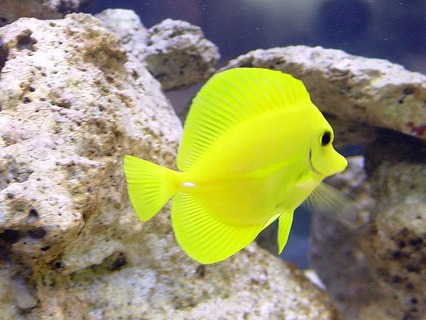
The Yellow Tang can be a semi-aggressive saltwater fish
When they want to be semi-aggressive, they will put that scalpel to no-good use, swatting it at a rival fish with intent to maim. Over the years, I’ve had a few fish end up with a cut as a result of a tangle with them.
Reproduction
One of the greatest breakthroughs in aquarium husbandry over the past decade was when the Oceanic Institute announced they had successfully cultured yellow tangs, shattering the previously impossible task of rearing the major broadcast spawners in an aquarium-setting.
This was a monumental task because the larvae are so small when the eggs hatch and require such delicate care and feeding. Their facility was producing tens of thousands of eggs daily (Callan 2016).
As a result, a limited number of aquacultured yellow tangs are available in the market–and I expect the availability to grow over time.
Feeding
With their beak-like snouts and narrow faces, yellow tangs were built for eating algae out of crevices in coral and between rocks. Their daily routine is pretty much built around grazing and eating all day long. They need to have access to lots of algae.
Yellow tang diet
On the reef, the Yellow tang diet consists primarily of both microalgae and macroalgae, depending on what’s available to eat, however, it is thought that the yellow tang diet does naturally skew more heavily towards the microalgae (Michael 2015). However, like you or I, a Yellow tang diet is heavily dependent on what there is around to eat. Yellow tangs are known to eat brown, red, green, and even blue-green algae (Michael 2015).
Here is another interesting dietary fact and trivia word. In addition to being mostly herbivorous, the yellow tang diet also contains coprophagous um…substances…which (giggle), means fish poop is also officially in their diet (Michael 2015).
What do yellow tangs eat?
Yellow tangs eat microalgae (algal films), as well as macroalgae and fish poop. The digestion of these tough, cell-wall rich foods is assisted by symbiotic protozoans that live in their digestive tracts (Michael 2015).
Remember that, the next time you’re tempted to dose an antibiotic in your tank.
In terms of macroalgae, yellow tangs eat Filamentous algae, blue-green algae, brown algae, green algae, and red algae.
They are herbivores by nature and will gladly snack on nori and other seaweed-based food options. To give them the most natural access to this food source it is a good idea to distribute it around the tank tucking it under rocks and creating opportunities for them to find it.
The tangs in my tank also tended to eat spirulina flakes aggressively, too.
Even though their preferred/natural food is plant-based, that won’t stop them from eating meat-based foods. My tangs greedily ate mysid shrimp, blackworms, and brine shrimp, as well. To keep them happy and healthy, they should be fed at least 3 times a week, although most people will try to feed them daily.
Disease
These fish are susceptible to ich and many other parasites. A quick scan of some hobby forums will turn up many examples of parasites in yellow tangs, in fact, it is startling how many of the example pictures of diseased fish are yellow tang.
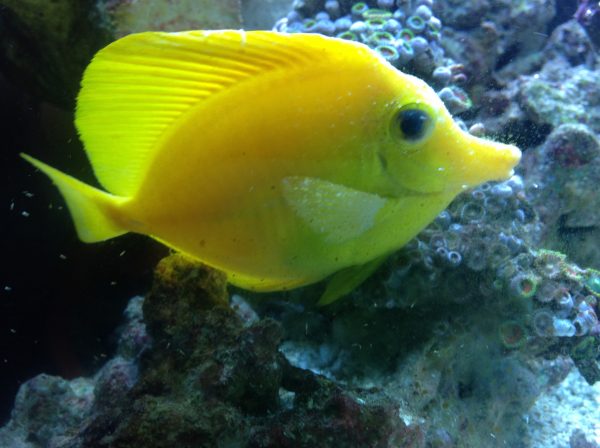
saltwater ich on a yellow tang. Wikimedia creative commons
A quarantine tank is necessary for any hobbyist, but it seems to be more important if you are getting yellow tangs. It is important to quarantine them before introducing them to your display tank.
All yellow tangs are wild-caught and can come diseased from the ocean. They seem to be parasite magnets, picking up critters somewhere along their journey.
How to catch a yellow tang
If you ever have to catch and remove or transport your yellow tang, don’t catch them directly in your aquarium net. Instead, use the net to corral them into a hard plastic specimen container, to avoid snagging their spine (Michael 2015).
Yellow tang for sale
If you are interested in adding one of these vibrant fish to your tank, online stores that will ship them, via overnight delivery, right to your door. The other way, of course, is to head to your local fish store. Be sure to follow proper acclimation and quarantine procedures, to give your new purchase the best chance and to ensure you have access to any live arrival guarantees.
Conclusion
If you haven’t already considered adding a yellow tang to your reef aquarium, you should. They’ve been an enjoyable and vibrant part of my tank for most of the years I’ve had it.
Why do I love them so much?
- They are gorgeous
- Lively, active, and hardy
- Get along well with most tankmates
- Grow reasonably fast
- Easy to care for
- Only slow down at night
There is no shortage of reasons why the yellow tang is one of the most common fish in hobby aquariums. But keep in mind, while they are easy to care for, they do have some special considerations. They are susceptible to disease, prone to aggression in some cases, and can sometimes cause problems for some types of coral because of their feeding habits.
If treated properly, the yellow tang fish will add color and character to your display tank for many years to come, because they can live as long as 10 years!
Have any questions about caring for the yellow tang? If so, please ask it in the comments below.
Learn about other great tankmates for the yellow tang
Looking for a few great options to keep with a yellow tang? Read more:
The yellow tang is also reef safe and can be kept with LPS, SPS, Soft corals, mushrooms, and zoanthids.
Alternatives
Looking for an alternative to the yellow tang?
Check out a few of these other tang species:
Or these yellow fish:
References:
Callan, Chatham K. “Striking Gold: The Dream of Breeding Zebrasoma flavesens Comes True in a Hawaii Marine Lab”. Coral: The Reef & Marine Magazine: Volum 13: Issue 1 Jan/Feb 2016.
Michael, Scott W. ” Fishy Grazers on the Reef and in the Aquarium.” Coral: The Reef & Marine Magazine: Volume 12: Issue 4 Jul/Aug 2015.

[ad_2]
Source link

